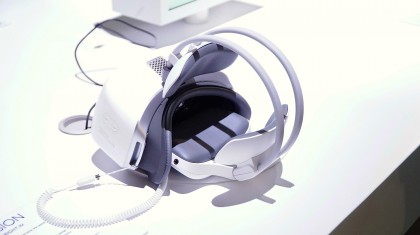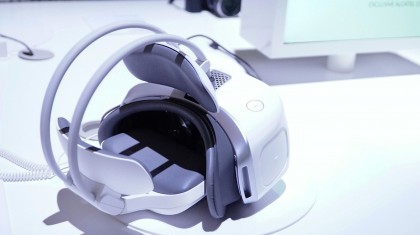Early Verdict
Alcatel's phone-free answer to mobile VR may offer a wider field of view and potentially a more comfortable design than the rest, but a high projected price for what's on offer makes us wish it just relied on a phone like its rivals.
Pros
- +
No phone needed
- +
Interesting ergonomic design
- +
Wide field of view
Cons
- -
Maybe it should use a phone?
- -
Fit isn't easily adjustable
- -
Likely to be pricey
Why you can trust TechRadar
Alcatel, a phone maker known better in the UK and Europe than in the US, is the latest of the bunch to issue a virtual reality (VR) headset, here at IFA 2016. However, this one, called simply Vision, is a bit different from your Samsung Gear VRs or LG VR 360s of the world.
This one doesn't need a phone at all. We know, weird, right?
The Vision, with its own battery pack and display(s), offers VR games, movies and other content independent of any device. However, after some time with the device on the IFA show floor, we kind of wish it wasn't.
A smart (but flawed) design
Alcatel's Vision employs a unique design that's more ergonomic than most of its rivals in that it doesn't use straps to secure the device to your eye sockets. Rather, the Vision features two bars that arc backward over your head to two padded portions that rest just above your neck.
(Another padded portion sits just above the headset, resting itself on your forehead.)
This design serves two purposes. For one, it distributes the weight of the device more evenly, and more importantly, away from the front of your face.
Secondly, that large padded portion of the device just above the neckline isn't just for comfort. Inside is a 3,000mAh battery that can power the whole experience for as long as three hours. (The unit charges via a micro USB port just beside the left lens inside.)

That's enough time to watch, say, a Lord of the Rings film (not the extended cuts, mind) in an IMAX-grade, 120-degree field of view (FOV), which Alcatel says is the widest in its class. That FOV handily beats LG's 80 degrees and Samsung's 96 degrees – even the Oculus Rift and HTC Vive's 110 degrees can't beat that.
But, back to wearing the thing. Despite this smart, ergonomic design, we found the headset to be tough to adjust for an optimal fit, if at all. (An Alcatel booth representative didn't seem to know much better, and we weren't about to break a demo unit to find out.)
So, while playing a game of developer Magic Interactive Entertainment's BattleBlock (a Tron-like disc throwing game), the headset kept slipping down the bridge of our nose.
Holding the headset up to your eyes with your left hand while the right uses the touchpad sat on that side of the headset to control a game or navigation isn't exactly the most comfortable experience.
Of course, being pre-production hardware, this issue could (and should) be resolved before the headset hits shelves in the US in the first quarter of next year.
So, if it's not a phone, what's in there?
The funny thing about the Vision being free of any phone or other device is that, well, there's basically a smartphone inside. Powering the Vision is an octa-core processor supported by 3GB of RAM and 32GB of flash storage.
On the connectivity front, the Vision houses Bluetooth, LTE and Wi-Fi radios. Rounding out the package is an array of sensors including an accelerometer, gyroscope and proximity sensor.
The whole system runs on a version of Android Marshmallow behind two, 3.8-inch AMOLED displays, each at 1,080 x 1,020 resolution (for an effective combined resolution of about 2,160 x 2,040).

For all intents and purposes, there's a phone inside this device powered by a relatively large battery.
When you've gotten that close to housing a phone inside your independent mobile VR device, while an admirable feat, we almost wish Alcatel would've just went with a phone-based system in the first place.
Early verdict
The Alcatel Vision may have beat its rivals in terms of field of view and in providing an all-in-one mobile VR solution, but the benefits of the latter are, at least judging from our limited time with the device, nil.
Considering the device has smartphone-grade components inside and an effective QHD display – not to mention phone VR-grade battery life – the visuals really look about just as good (or bad) as any other phone-based headset solution. And, just like phone-based VR, a web of pixels is glaringly noticeable throughout, and the graphical fidelity is comparable to that of an Xbox 360 or PS3.
With Alcatel said to be aiming for a price between $500 and $600 for the Vision, we would expect a bit more from this solution considering you could pick up a Google Cardboard or a comparable device paired with your phone for a fraction of the cost.
That's before even considering that, despite Alcatel's partnerships with Jaunt VR and Magic Interactive Entertainment to fuel the Vision with VR content, the ubiquity of the app stores will always guarantee more content than a proprietary solution.
We're interested in playing more with the Alcatel Vision's clever, ergonomic design in a full review, but the outlook from our brief time with the device already isn't terribly promising.
Joe Osborne is the Senior Technology Editor at Insider Inc. His role is to leads the technology coverage team for the Business Insider Shopping team, facilitating expert reviews, comprehensive buying guides, snap deals news and more. Previously, Joe was TechRadar's US computing editor, leading reviews of everything from gaming PCs to internal components and accessories. In his spare time, Joe is a renowned Dungeons and Dragons dungeon master – and arguably the nicest man in tech.
What is a hands on review?
Hands on reviews' are a journalist's first impressions of a piece of kit based on spending some time with it. It may be just a few moments, or a few hours. The important thing is we have been able to play with it ourselves and can give you some sense of what it's like to use, even if it's only an embryonic view. For more information, see TechRadar's Reviews Guarantee.

